A few days ago this female kingfisher landed close to me with a meal so I was able to document the gritty details of the demise of the fish.
After capturing a fish Belted Kingfishers pound their prey against a perch by rapid sideways movements of their heads. This stuns the fish and provides a means of turning it so it can be swallowed head first. It may also serve to break the sharp spines of some fish species such as bullheads and sticklebacks.
All images are presented in the order they were taken.
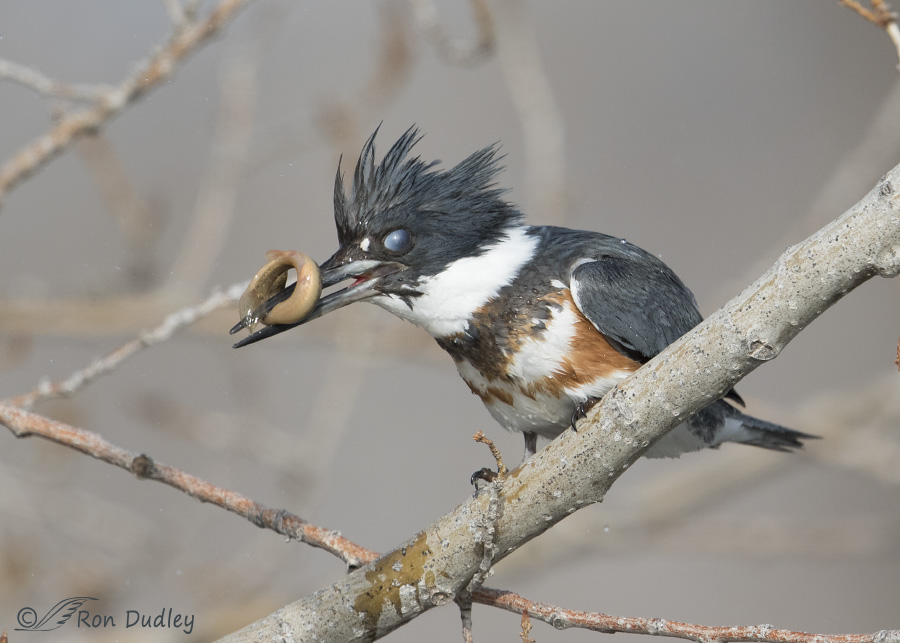
1/1600, f/7.1, ISO 500, Canon 7D Mark II, Canon EF 500mm f/4L IS II USM + 1.4 tc, not baited, set up or called in
This frenetic activity poses a real threat to the eyes of the kingfisher, especially in a case like this where the fish (a Weather Loach) is long-bodied and may slap against the eyes of the bird, so in many of my images she has closed her nictitating membrane. Here we see the slimy wet spot on the perch where the fish has already been pounded against the branch. The actual pounding was so fast that most my images of it at this shutter speed were soft so I haven’t included many of them here.
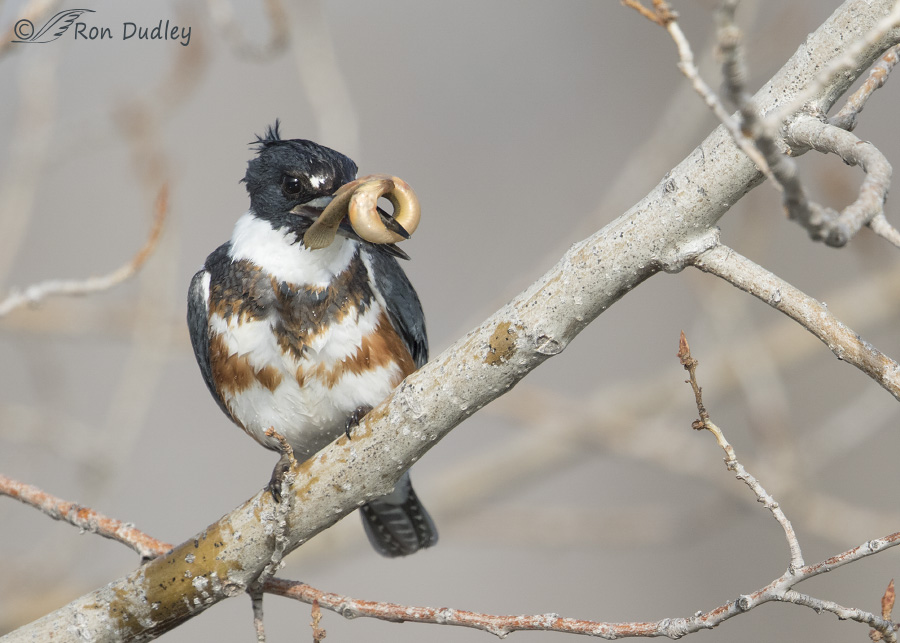
1/1600, f/7.1, ISO 500, Canon 7D Mark II, Canon EF 500mm f/4L IS II USM + 1.4 tc, not baited, set up or called in
The loach was extremely squirmy and at times I half jokingly considered the possibility that the fish was deliberately trying to use its long, eel-like body to tie a knot around the kingfisher’s bill in order to prevent the bird from swallowing it.
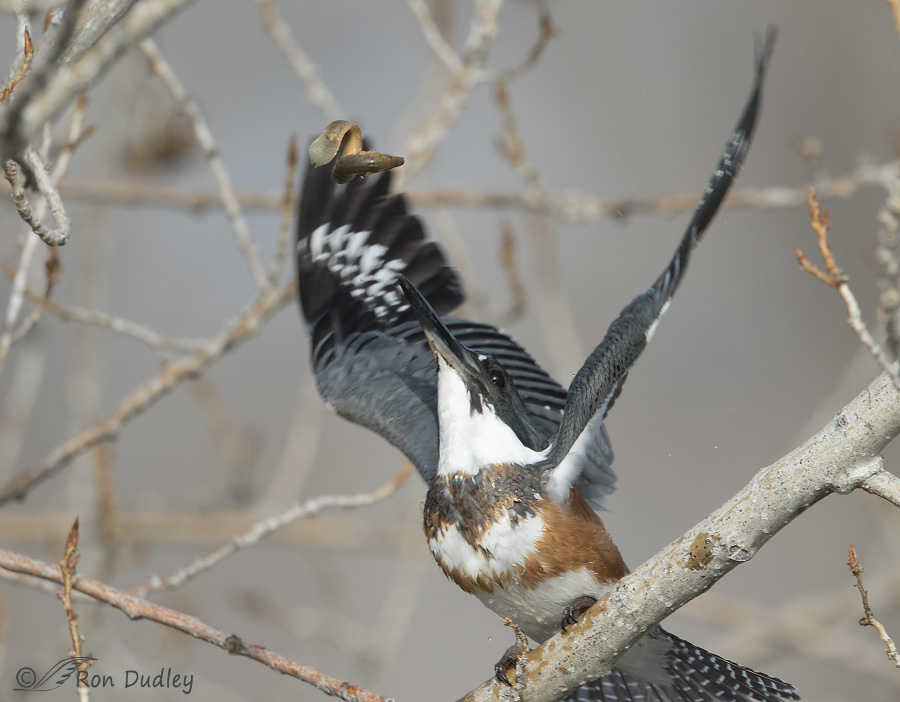
1/1250, f/7.1, ISO 500, Canon 7D Mark II, Canon EF 500mm f/4L IS II USM + 1.4 tc, not baited, set up or called in
The kingfisher tossed the loach into the air and caught it again at least once. To be honest I didn’t even know this had occurred until I reviewed my images at home. At this shutter speed nothing in the image is tack sharp except the fish so I must have caught it at its apex when it was moving slowly.
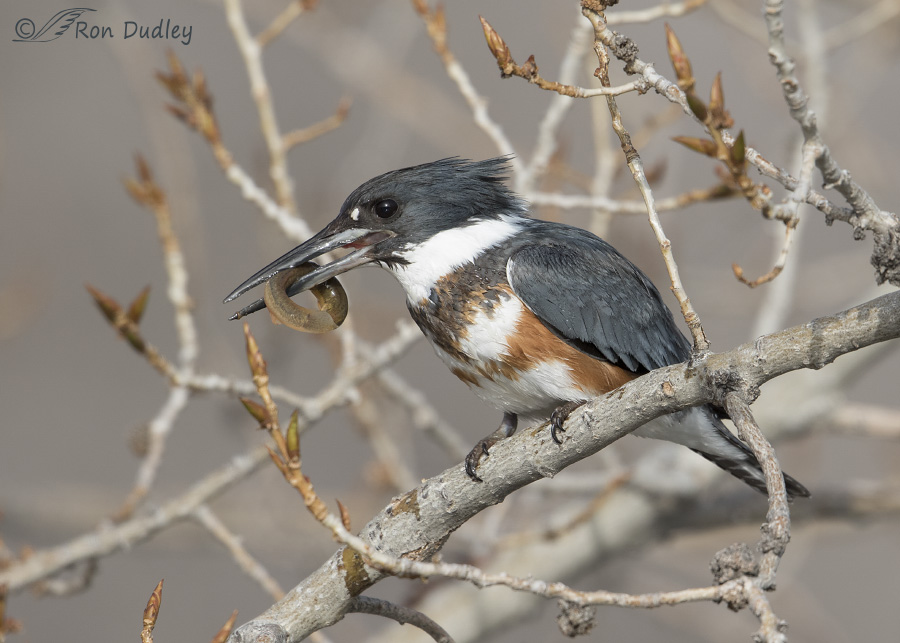
1/1000, f/7.1, ISO 500, Canon 7D Mark II, Canon EF 500mm f/4L IS II USM + 1.4 tc, not baited, set up or called in
At this point the kingfisher had moved to a different and more cluttered area of the branch.
I had to include this image because I was intrigued by the perfect closed circle formed by the body of the loach. Sometimes it doesn’t take much to entertain me…
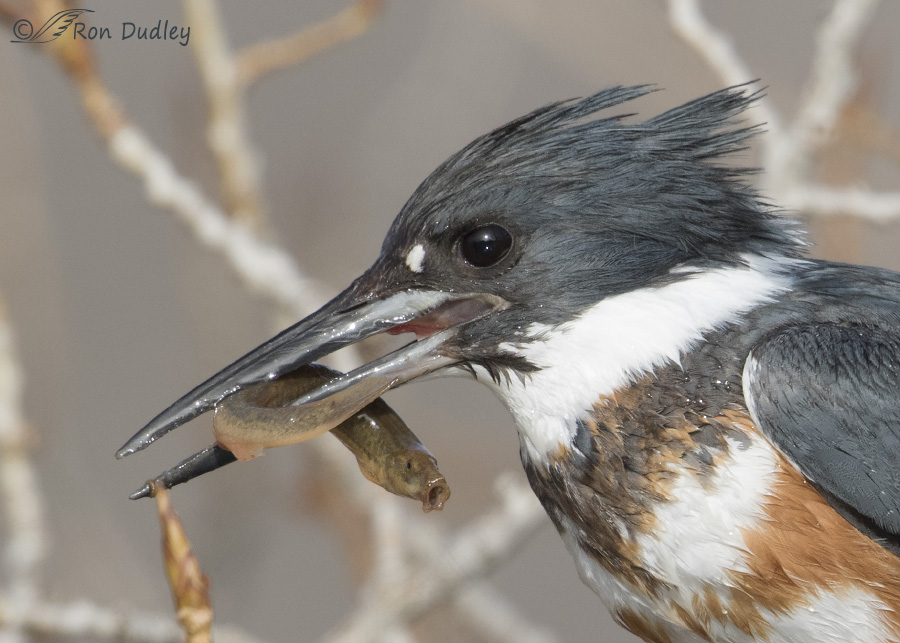
1/1000, f/7.1, ISO 500, Canon 7D Mark II, Canon EF 500mm f/4L IS II USM + 1.4 tc, not baited, set up or called in
Since the loach was one of the stars of the show I figured it deserved a closer look before its demise. Poor little guy.
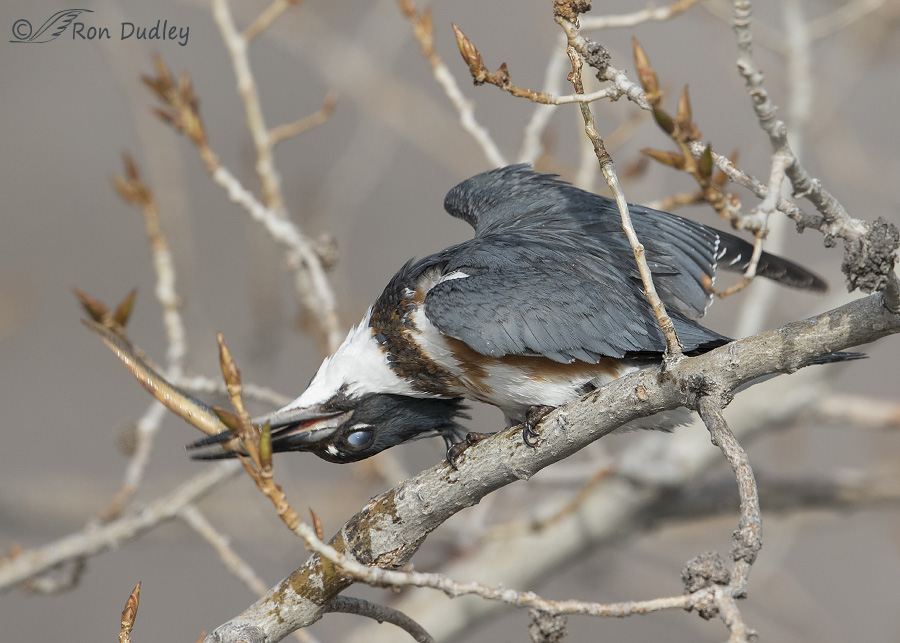
1/1000, f/7.1, ISO 500, Canon 7D Mark II, Canon EF 500mm f/4L IS II USM + 1.4 tc, not baited, set up or called in
The kingfisher repeatedly slapped the fish against the branch so hard that the bird’s head was often completely upside down. By comparing this shot to previous images we know the approximate number of times the fish hit the branch by counting the number of wet spots on the perch (one of them even looks like a fish head, complete with eye).
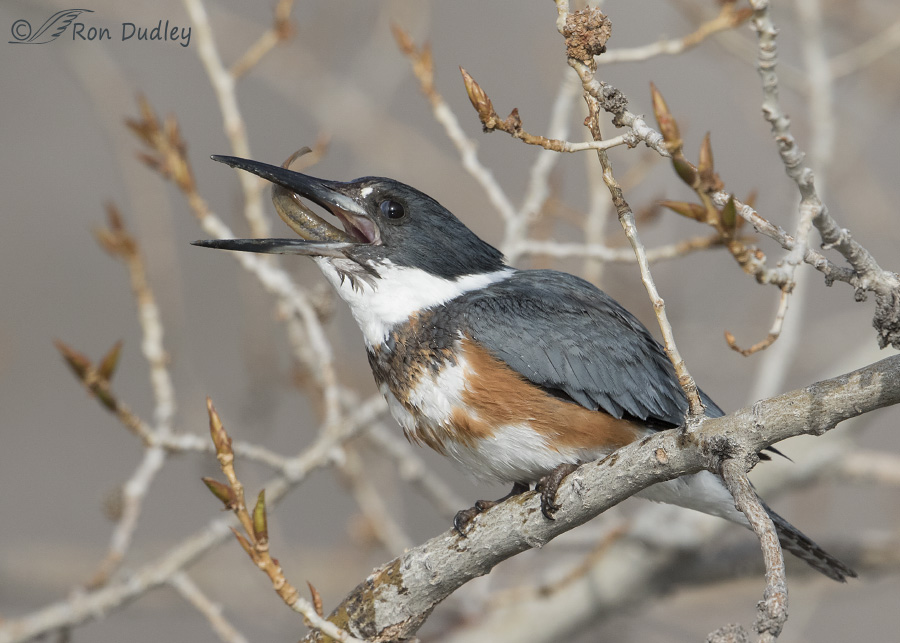
1/2000, f/7.1, ISO 500, Canon 7D Mark II, Canon EF 500mm f/4L IS II USM + 1.4 tc, not baited, set up or called in
The loach had now been “tenderized” enough for the swallowing process to begin.
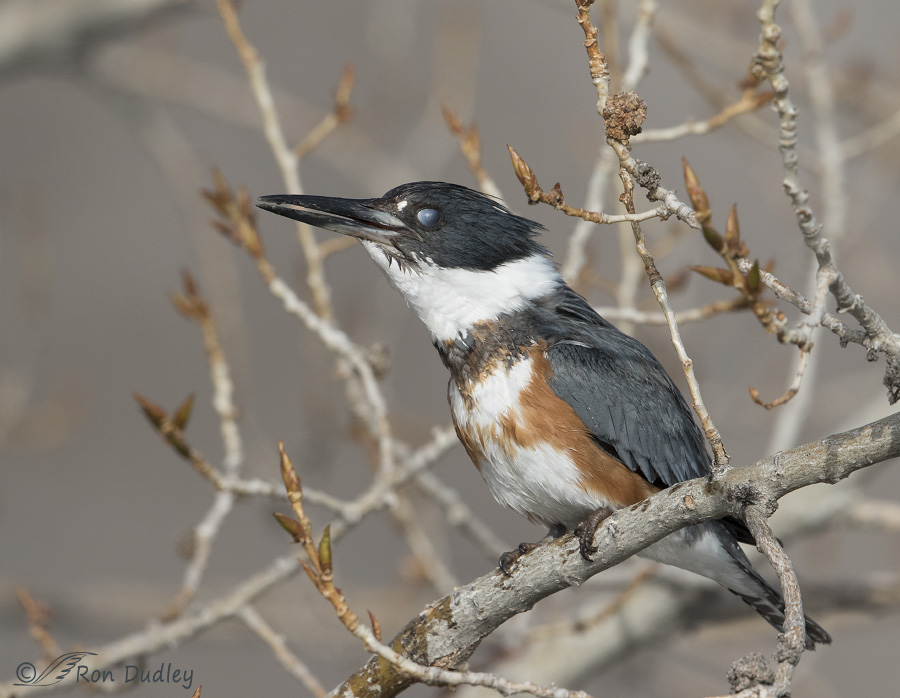
1/3200, f/7.1, ISO 500, Canon 7D Mark II, Canon EF 500mm f/4L IS II USM + 1.4 tc, not baited, set up or called in
I’ve noticed that some bird species, many raptors in particular, typically close their nictitating membranes as their prey is sliding down the hatch. At this point in the process I’m not sure why it’s necessary – perhaps there’s some anatomical or physiological reason for it.
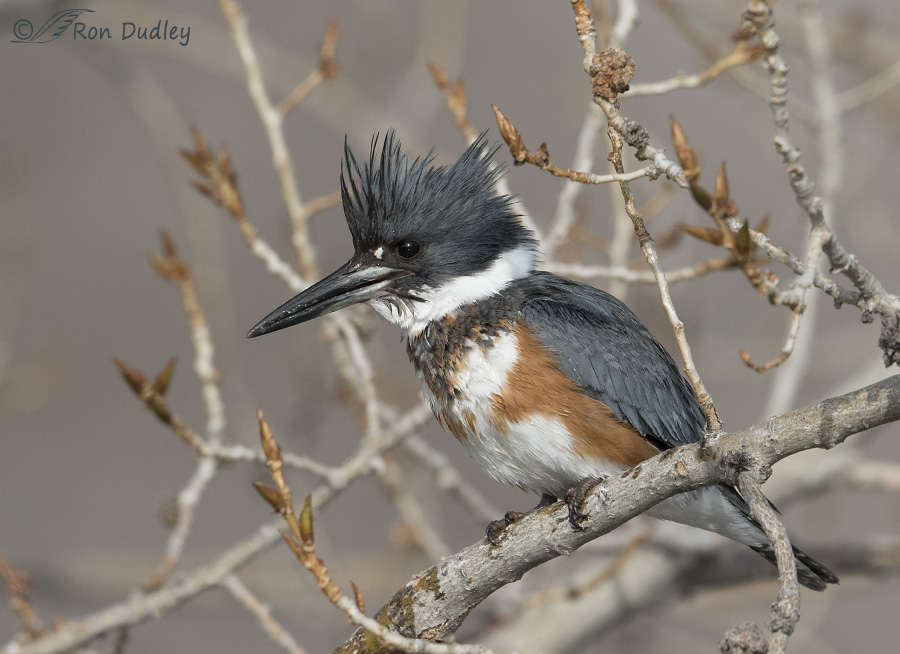
1/3200, f/7.1, ISO 500, Canon 7D Mark II, Canon EF 500mm f/4L IS II USM + 1.4 tc, not baited, set up or called in
After the fish was swallowed the kingfisher held this pose for some time. Perhaps it was reveling in its success or enjoying its full belly (or waiting for the fish to stop squirming down there…)
I’m hoping for another chance at this bird soon because I suspect that it won’t be long before she abandons the area to breed – there are no steep river banks close by (that I’m aware of) for her and her mate to dig their burrow.
I suppose it’s actually possible that I could get lucky with her twice.
Ron


Awesome series, Ron. I know I’m a little late to the party but work has had me buried this week.
This is one jaw-dropping series Ron! Congratulations on your well-deserved photographic triumph. The images are extremely well done and the behavioral insights are plentiful. As someone who laments invasive species whether they’re aquatic or terrestrial, I am thrilled that beautiful bird has taken at least one of those ecosystem imbalencers out of the Jordan River. I trust there’s many more where that one came from.
Eat, Mrs. Kingfisher, eat!
Wow wow wow! What a series!
Love the shot of the toss but that line about waiting for the loach to stop squirming in her belly? SHUDDER. You got me on that one.
Good, Arwen! I was after somebody…
A STUNNING series of kingfisher shots. As hard as it is to get close to these guys, you had my hat off with the first high-quality image.
Thanks, Howard. This was my first time this close and the bird came to me.
Food preparation is a chore whatever the species it seems.
And it looks as if the Kingfisher needs to extend considerable energy to tenderize its dinner too. I am not surprised she shut her eyes and had a little rest while swallowing…
Fascinating series. Again.
“Food preparation is a chore whatever the species it seems”
I’m glad I like to cook, EC – for me it usually doesn’t seem like a chore but I can see how it could turn into that.
I – am – speechless!! Absolutely fantastic! I learn so much more from your posts than I do from bird books or the internet! Thank you for sharing your images and knowledge with us!
Thanks very much, Jane.
Beautiful and fascinating! It doesn’t seem unreasonable to guess that forming a circle when under attack makes the loach as sizable and therefore as difficult as possible to swallow. I was moved by your empathy for the loach. This sequence also helps me appreciate how easy we have it to not regularly be prey, and to get our food out of a store. I’d hate to be whacking everything to death every time I wanted concentrated protein!
“This sequence also helps me appreciate how easy we have it to not regularly be prey”
Boy, isn’t that the truth, Alison!
It’s ironic and tragic that the major killer of us… is us.
Great set Ron, wonderful series! I think the closing of the nictitating membranes is in fact anatomical/nerves as the fish/food moves down the gullet.
A fact that we had to deal with in our past – little get eaten by the larger and the larger get eaten by the biggest. Can’t look at a vole and not think that it is fodder for hawks and owls.
What would have Kingfishers eaten at this place if they didn’t have Weather Loaches?
“What would have Kingfishers eaten at this place if they didn’t have Weather Loaches?”
Thanks, Dick – there’s a variety of fish in the Jordan River and associated ponds – DWR lists the following species:
•Black Bullhead Catfish
•Black Crappie
•Bluegill
•Channel Catfish
•Common Carp
•Rainbow Trout
•Utah Chub
•Utah Sucker
•Walleye
•White Bass
•Yellow Perch
Boy, that suggests that there must be a lot of Weather Loach. Are the Weather Loach impacting some of these other fish that you know of?
Ron, wouldn’t the fish on your list be to big for a kingfisher to catch/eat? Sounds like a good buffet for a bald eagle, or bears and other critters, but not kingfishers. Am I missing something here?
Laura, most of the species on that list reproduce naturally in the Jordan River. The kingfishers would only eat the young, small ones. They really cannot swallow anything very big.
Yes, I realize they’d eat the young ones, but that doesn’t give them a food supply (beyond the loaches) for the entire year. Sorry, I didn’t include that part of my thoughts–busy today putting out fires!
“but that doesn’t give them a food supply (beyond the loaches) for the entire year
Actually, I’d guess that it does, at least partially. Some of these fish aren’t very large even as adults and fish grow slowly so even after many months I suspect that some of them are still small enough for kingfishers. But what do I know…
And kingfishers aren’t strictly fish-eaters. They eat a variety of other things too. Here’s the list of food items (other than fish) that BNA lists for the species: “Also molluscs, crustaceans, insects, amphibians, reptiles, young birds, small mammals, even berries”
Can you tell I’m not a fisher person beyond watching eagles catch them? LOL! And I COULD have looked up the other information, too. Alas, I’ve learned from the raptors that slaves are good. LOL! THANKS!
“Are the Weather Loach impacting some of these other fish that you know of?”
Not that I’m aware of, Dick.
A few years ago I reported the presence of Weather Loaches at Farmington to the fisheries folks at DWR. At that time they were already aware of them in the Jordan River but not at Farmington. They were very interested to know they were there but didn’t seem (to me) to be very concerned about it so that makes me think that they don’t worry much about their potential impact (rightly or wrongly…).
Thanks Ron.
Fantastic sequence Ron. Looks like she enjoys donuts too–just that she prefers fishy tasting to chocolate!
Ha, I thought the fish in that image looked like a donut too, Larry.
So loved this series today, Ron!! I also noticed that her topknot was up in the 1st and last photos but in the rest the crest was laid back down. He, he – the crazy things we see and are drawn to when viewing a photo!! After reading all of your descriptions, I had to go back and check out the nictitating membranes. What I found interesting is that the membrane was only present in the 1st, 6th, 8th and a slight amount of membrane in the 7th photo. In all the rest there was no membrane showing. It does make you wonder what the reason was that it wasn’t present in the other shots except fot the last??!! Maybe a need for oxygen exchange?? Oh the mysteries of life. I must say I’ve gotten awfully attached to this little female Kingfisher!! Will you be sharing any more of her?
“Maybe a need for oxygen exchange??”
Or maybe the need to see what what was doing occasionally, Jo Ann.
“Will you be sharing any more of her?”
Probably not for a while. I’ve already posted most of the interesting behavioral shots I got but somewhere down the line I may post just a few other images of her.
I am so intrigued by the behaviors you document,that I seldom even notice the occassional “softness” of an image…though I do notice the sharpness. Thiis has been an amazing series! I wonder how similar the behaviors of the Portugese Kingfishers and the American ones are “Worlds apart”…or are they???
Thanks, Patty. I don’t know for sure how similar they are but according to Jorge they match up pretty well and I have faith in what Jorge says about his birds in Portugal.
Just wonderful series, Ron, right down to the tiny droplets you caught in the air, on the Kingfisher, and around the loach–whose “last gasp” was so
compelling that I almost missed the droplets ( even you felt some sympathy for the slimy critter ! ) Every day I look forward to seeing what you’ve brought
home and learning some fascinating factoid from your observation—thanks !
“even you felt some sympathy for the slimy critter”
It’s hard not to feel at least some compassion when we see the critter up close and gasping like that, Kris. That’s why I posted that heavily cropped shot…
Some folks who have aquariums, really like loaches, and say that these fish are “friendly and responsive” to their keepers….most so than most fish….it ‘s hard not to feel sympathy fro any prey animal, especially when it’s sruggling to survive and something is beating the bejeekus out of it….
Ours kingfish have different colours (they are blue) but behave the same way. Depending on the size of the fish sometimes it has to slap the fish ten to twenty times before swallowing it.
Three interesting things about them:
They always lay seven eggs no matter the food resources or how the weather is.
Both parents take turns to hatch and to feed the little ones.
Being seven and to prevent a big fuss when parents arrive with food, they form a circle, back to back and the one facing the tunnel entry after receiving the food moves aside so the one on his left takes the place and so on till all of them get their share.
Awesome series. You have done an exceptional work here Ron. Congratulations.
The close up photo is my favourite.
Very interesting behavioral comments, Jorge…proves chivary and fairness are not dead. One our dogs does something similar. He lives to eat, but when he has gotten a treat, he moves aside so the females can get their share.
That’s supposed to “chivalry”. You know who is at it again?…
Sure, blame it on the innocent iPad…
Jeeeez! Whose side are you on?????
Thanks for the behavioral notes, Jorge. I found the third one particularly interesting – makes me wonder how that type of behavior evolved.
Well, there’s yet another series of WOWs! Fascinating!
I love the series of dinner preparation. I had an image of a top-of-the-line chef, preparing dinner (whether the subject of the dinner liked it, or not). Sometimes the star of the dinner show doesn’t appreciate the part where its killed and eaten and tries to kill the chef back. Sometimes, that strategy works out and the dinner escapes!
Thank you, Laura.
Neat series of images Ron! It is interesting to see this behavior up close. Do you notice whether the Kingfishers leave the area when there is no open water? (I ask since there was one hanging around the farm ponds here when we were in winter a few weeks ago and all the ponds appeared to be frozen over.). These images are super sharp!
“Do you notice whether the Kingfishers leave the area when there is no open water?”
I sure do, Ed. I’ve been looking for kingfishers in this area this winter but they’re not at this spot at least when there’s mostly ice.
You mention the sharpness. I was delighted that after my lens was “repaired” by CPS this entire series of hundreds of images of this bird was sharp except for those that didn’t have enough shutter speed to freeze the action.
REALLY nice sequence, Ron. Loach was definitely making her work for it. Perhaps the prey getting so close to the eye when swallowing triggers the nictitating membrane to close “just in case”.
Perhaps the prey getting so close to the eye when swallowing triggers the nictitating membrane to close “just in case”.
You may be right about that, Judy – it may be a reflex that the bird has no control over.
I shall have to observe my cat dog and finches swallowing and see if their nictating membranes move closed when they swallow… Interesting note that you caught in that frame! So enjoy your images…I take their quality for granted, I’m afraid, and simply learn so much about the subjects from them! Thank you!
Christina, I’ve always wondered why some predatory birds close their membranes when swallowing, even when that prey is already so far down the throat that it apparently doesn’t pose any threat to the eyes.
Wow Ron… another great series. Tack sharp, as always, except for that one frame (ha)… great story
well composed. You must smile when you look back at these images. Another great success. Well done. :-)))
Yep, this series, and the entire encounter, was a high point for me, Roger. I have so many images of this bird, and most of them are pretty good, that I’m having a very difficult time culling them. Thank you.
Love that toss up in the air!
I enjoy that shot too, Loren. I was very surprised that I didn’t even notice that toss through my lens.